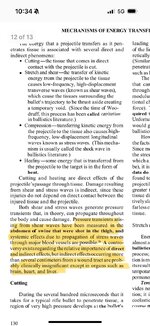May also want to read this.
Then this
This is not directed entirely at you however given your thorough response, which I appreciate, this is directed here as well to everyone else that has provided their opinion.
Saying ballistic pressure is a part of incapacitation is confirming the existence of energy and its affect on the target and tissue. "It exists and does contribute" is all we need to read from that portion of the paper to know. Furthermore the paper continued to reference ballistic pressure waves, calculations of energy, and transmission to surrounding tissue including the brain at impact. Think about when you spine an animal and it drops dead on the spot. The energy transfers through the spine and into the brain, causing a rupture at the medula and instant death.
So whether we discuss higher pressure waves, frangibles, or blunt force trauma - physics has proven through mathematical calculations that have been peer reviewed and verified through multiple outlets too numerous to quote - the existence of it energy in projectiles is proved. The amount is also proved depending on the size and speed of the projectile.
In simple terms, if you shoot an elk in the back hip with a 223 will it kill? Probably not. If you shoot an elk in an a vital area with a bullet that perhaps deviates from its original path, do you have a better chance of a kill by creating a hole PLUS a significant pressure wave - absolutely and without argument YES
Here it is in its simplest form
1. How does energy transfer occur in ballistics? In ballistics, energy transfer occurs through the transfer of kinetic energy from the bullet to the target. When the bullet strikes the target, the kinetic energy is transferred to the target, causing damage or penetration. e.g. "ringing steel"
2. What factors affect the transfer of energy in ballistics? The transfer of energy in ballistics is affected by several factors, including the mass and velocity of the bullet, the density and composition of the target, and the distance between the bullet and the target.
3. How does momentum play a role in ballistics? In ballistics, momentum is the product of an object's mass and velocity. It plays a crucial role in determining the trajectory and impact of a bullet. The greater the momentum of a bullet, the more force it will exert on the target upon impact.
4. What happens to energy and momentum after a bullet impacts a target? After a bullet impacts a target, the energy and momentum are transferred to the target, causing damage or penetration. Some of the energy and momentum may also be transferred to the surrounding environment, such as the adjoining tissue, in the air or in some cases pass to the ground.
5. How is the transfer of energy and momentum in ballistics calculated? The transfer of energy and momentum in ballistics can be calculated using the laws of conservation of energy and momentum. This involves measuring the mass and velocity of the bullet and the target, as well as the distance and angle of impact.
Reference:
https://www.physicsforums.com/threa...of-energy-and-momentum-in-ballistics.1014644/
HITS - HORNADY INDEX OF TERMINAL STANDARDS - Yes HORNADY
You can effectively calculate the impact of a bullet via the following series of steps.
Collect the required information for the ammunition under consideration. You will need to know the bullet
weight, measured in grains, which is listed on the ammunition box. You must also know the
velocity the bullet is moving at impact. Each ammunition manufacturer publishes ballistic tables for their ammunition. These tables will normally list the bullet velocity at the muzzle of the gun and at intervals of 100 yards out to the useful range of the ammunition (usually 300 yards or so). For distances between the listed increments, you must estimate.
Ammunition manufacturers typically measure rifle bullet velocities using a 24-inch test barrel. As a rule of thumb, for every additional inch of barrel length beyond 24 inches, the velocity increases by 20 feet per second. Likewise, for every inch of barrel length below 24 inches, the velocity decreases by 20 feet per second. For example, if your rifle barrel is 20 inches long, then subtract 80 feet per second from the manufacturer's stated velocity. There is no such rule of thumb for pistol ammunition.
You also will need to know the bullet
diameter. Precise diameters can be found in tables published by ammunition manufacturers. Otherwise you can use the bullet caliber as an approximation. A 30-06 bullet has a diameter of 0.308 inches, but you could use 0.300 inches in your calculations without significantly compromising accuracy.
Calculate the energy the bullet will deliver to the target on impact using the formula
𝐾𝐸=𝑤𝑏𝑣2450,437KE=450,437wbv2
In words, the bullet energy KE (in foot-pounds) is equal to the bullet weight (in grains) wb times the square of the bullet velocity v (in feet per minute) divided by 450,437.
Calculate the
Hornady Index of Terminal Standards (HITS) number using the formula
𝐻𝐼𝑇𝑆=𝑤𝑏2𝑣700,000×𝐷2HITS=700,000×D2wb2v
In words, the HITS number is equal to the square of the bullet weight (in grains) times the velocity (in feet per second) divided by the square of the bullet diameter (in inches) divided by 700,000.
This is why energy is also listed on nearly every single box of ammunition you can buy, to guide the hunter is picking a bullet that has the HIGHEST probability of exerting the amount of energy to kill, in addition to making the hole.
Once again, the transfer of energy by projectiles is a fact. The amount is variable based on many factors. To say it does not have an affect is - to use a term folks use here all the time - "fuddlore"

